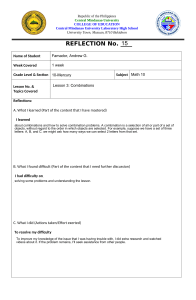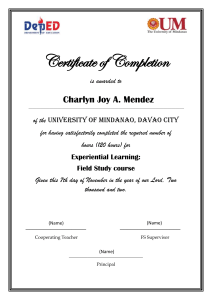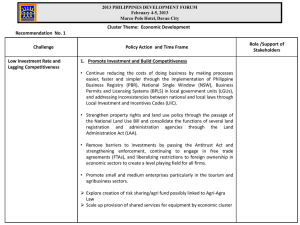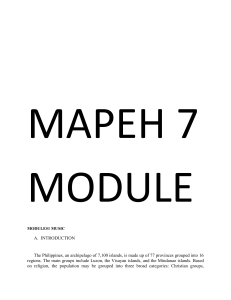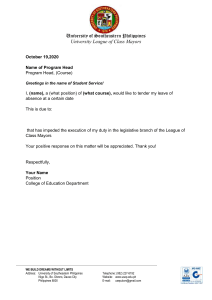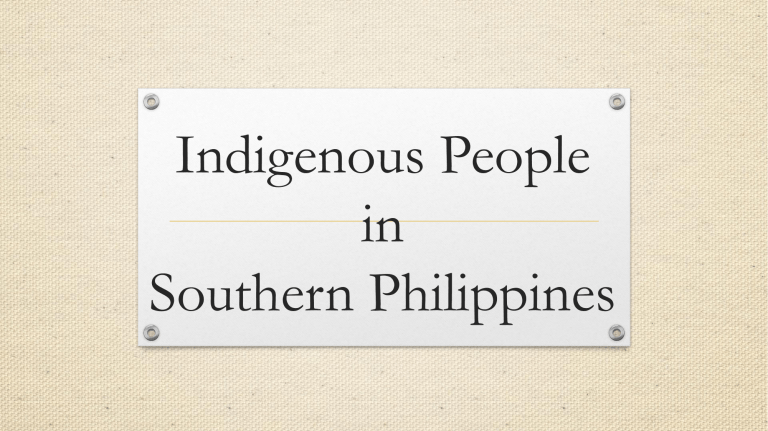
Indigenous People in Southern Philippines Badjao • The Badjao are an indigenous group in the Philippines, known as sea nomads. According to a study[1], they have been in the country since 500AD; described as endemic fisherfolks who have been using sustainable fishing methods for over 1,500 years. Ubo • The Ubo are a Manobo sub-tribe who inhabit the more isolated mountains of Southwest Cotabato in the area known as Datal Tabayong, as well as, more southerly Davao del Sur. As of last count, they numbered close to 17,000 (OSCC, 1987) B’laan • The Blaan Tribe are one of the indigenous people (IP) living in Southern Mindanao. They have their own traditional dance and music, colorful tribal wear and weaving tradition similar to the T'boli. The product of their weaving is called Tabih (T'boli call it T'nalak) and they have their own dreamweavers too! Ilianen • The Manobo tribe who are inhabitants of the island of Mindanao in the Philippines are a group of people speaking one of the languages that belong to the Manobo language family. Their origins can be traced back to the early Malay peoples who came from the surrounding islands of Southeast Asia. • Kalagan • The Kalagan live between the coast and the B'laan country in Davao province, and along the tributaries of the Malita, Lais and Talaguton rivers. They have traditionally lived in small, warring groups. At present, corn, which can be cropped 2 or 3 times a year, is gradually supplanting rice as the staple crop. Mandaya • The Mandaya tribes refers to a number of indigenous groups found along the mountain ranges of Davao Oriental, Davao del Norte, and Surigao del Sur. They are also recorded to be present in Mount Kampalili, in the highlands of eastern Mindanao. Manguangan • The Manguangan of Philippines, numbering 11,500, are Unengaged and Unreached. They are part of the Filipino, Tribal people cluster within the Malay Peoples affinity bloc. This people group is only found in Philippines. Their primary language is Dibabawon Manobo. The primary religion practiced by the Manguangan is ethnoreligion. Ethnoreligion is deeply rooted in a people's ethnic identity and conversion essentially equates to cultural assimilation. Manobo • The Manobo is a group of Indigenous people in the Philippines they mostly live in Sarangoni,Agusan Del Sur,Davao Province,Bukidnon and South Cotabato. She wants people to understand that indigenous children are just like any other child-they also deserve a happy childhood. Arumanen • The Arumanen's traditional means of subsistence are food gathering and swidden agriculture.The men Build houses,hunt,Fish,trap,and fall trees in preparation for clearing the fields. They hunt pigs,deer, chicken,and various kinds of fowl with traps,spears,bows and arrows and hunting dogs. Bukidnon • The Bukidnon are a culturally Indigenous Visayan gruop of people who reside in the Capiz-Lambunao mountainous area and the Antique-Iloilo mountain area of Panay in the Visayan Islands of the Philippines. Higaonon • The Higaonon is one of the 110 gruops of Indigenous people in the Philippines.The higaonon people are mostly concentrated in the northern and eastern,part of the province of Bukidnon, Mindanao Island Matigsalug • The Matigsalug are a Indigenous group live in the Tigwasalug Valley in San Fernando in Bukidnon province Philippines."Matigsalug"means "people along the Salug River"Although often classified under the Manobo ethnolinguistic gruop the matigsalug are a distinct sub group from the manobos. Tighawanon • The Tighawanon are neighboring ethic gruops in the province of bukidnon.Both peoples are considered to belong to the manobo family representing the oldest assumed stage in the development. Umayamnen • The Umayamnens live along the watershed of Umayamnen river in Bukidnon Province. The Umayamnens are known to be proud and reserved people, firm in their decisions, and forest experts. • The Umayamnons are engaged in beadworks for their body accessories such as the making of ginakit and inaboy(necklaces), suning(mens bags), and binuklad (bracelets). Sama • The Sama, also called Samal or Isama, is one of three ethnic groups in the Sulu Archipelago, the others being the Yakan and the Tausug. The etymological origin of the word is not yet clear, although one conjecture is that “Sama” may have derived from the word sama-sama, meaning “togetherness.” The language of the Sama is Siama or Sinama, also called Bahasa Sama, Bisla Sinama, and Pamong Sinama. Other groups speaking the Sinama language or variations thereof are the Sama Dilaut, also known as Badjao, the Jama Mapun (West Sama) of Cagayan island, the Yakan, and the Balangingi of the Samales Island group. Jama Mapun • JAMA MAPUN Is the native inhabitants of the Cagayan de Tawi-Tawi (Cagayan de Sulu) or Mapun and the Turtle Island where it is closest to Sabah, Malaysia. They are also found in northern Palawan and other nearby islands. • Jama Mapun is from the word Jama meaning people, and Mapun which indicates the name of the Island Municipality of Mapun, thus called the “People of Mapun” . They are one of the Bangsamoro Ethnic tribes in the Philippines. They are the Samaspeaking people widely known for their creativity and traditions.Their spoken language is called Pullun Mapun meaning Mapun Language.They speak a Sama-Bajau language of the Austronesian language family, and most are adherents of Islam. The Jama Mapun are socially independent, peaceful and creative people. Some of their principal economic activities are dry-rice agriculture, copra production, and trading. Sangil • Sangil descended from Sangihe, an archipelago in Eastern Indonesia, from where they hailed; the tribe was already Muslim long before they came to the Philippines and, ahead of the introduction of Islam to Mindanao. Subanon • The Subanon (also spelled Subanen or Subanun) is an indigenous group to the Zamboanga peninsula area, particularly living in the mountainous areas of Zamboanga del Sur and Misamis Occidental, Mindanao Island, Philippines. The Subanon people speak Subanon languages. • The name is derived from the word soba or suba, a word common in Sulu, Visayas, and Mindanao, which means "river", and the suffix -nun or -non, which indicates a locality or place of origin. Accordingly, the name Subanon means "a person or people of the river".[9] These people originally lived in the lowlying areas. However, due to disturbances and competitions from other settlers like the Moros, and migrations of Cebuano speakers to the coastal areas attracted by the inviting land tenure laws, further pushed the Subanon into the interior Kalibuga • Kalibuga” (Kolibugan) means “mixed breed” and refers to the Subanun of the Philippines who have intermarried with the Tausug and Samal. Kalibugan, who number about 15,000, live in villages on the coast in western Mindanao. Most have converted to Islam. Tagakaolo • The Tagakaulo people are located on the island of Mindanao in the southern Philippines. They number over 100,000 and reside in primarily three provinces: Saranggani, Davao del Sur, and Davao Occidental T’Boli • The T'Boli are one of the 87 tribal groups in the Philippines which make up 15 percent of the population. They number approximately 60,000 and reside inland from the southern coast of Mindanao Tasaday • The Tasaday were a hoax when viewed as a group of paid actors that paraded around the forest wearing leaves, but they were authentic if they were viewed as a forestdwelling group of people caught in the midst of the media,” Headland concluded in his 2009 story titled "The Tasaday Controversy: Assessing The Evidence. Tiruray • There is considerable interaction with the Magindanao, particularly with respect to trade. The Tiruray are very accomplished craftspeople, weaving exquisite baskets covered with distinctive motifs. They also make earrings, pendants, and necklaces out of horse hair. Yakan • The word Yakan means “Dayak Origin,” as they are believed to be descendants of the Orang Dyaks or Tagihamas of eastern Indonesia. They speak a dialect of Sama language and are culturally influenced in some respect by the Tausug. The Yakans' chief means of livelihood is farming, and they usually cultivate upland rice. Thank You!!!
